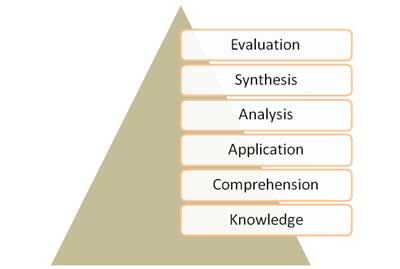Note: This site is moving to KnowledgeJump.com. Please reset your bookmark.
Bloom's Taxonomy: The Original Cognitive Domain

Lorin Anderson, a former student of Bloom, and David Krathwohl revisited the cognitive domain in the mid-nineties and made some changes. This newer version is discussed here, while the original is discussed below.
Cognitive Domain

The cognitive domain involves knowledge and the development of intellectual skills (Bloom, et al, 1956). This includes the recall or recognition of specific facts, procedural patterns, and concepts that serve in the development of intellectual abilities and skills. There are six major categories of cognitive processes, which are listed in order below, starting from the simplest to the most complex. The categories can be thought of as degrees of difficulties. That is, the first ones must normally be mastered before the next one can take place.
Table of The Cognitive Domain (original)
Category |
Example, Key Words (verbs), and Technologies for Learning (activities) |
Knowledge: Recall data or information. |
Examples: Recite a policy. Quote prices from memory to a customer. Know the safety rules. Define a term. Key Words: arranges, defines, describes, identifies, knows, labels, lists, matches, names, outlines, recalls, recognizes, reproduces, selects, states Technologies: bookmarking, flash cards, Internet search, reading |
Comprehension: Understand the meaning, translation, interpolation, and interpretation of instructions and problems. State a problem in one's own words. |
Examples: Rewrites the principles of test writing. Explain in one's own words the steps for performing a complex task. Translates an equation into a computer spreadsheet. Key Words: comprehends, converts, diagrams, defends, distinguishes, estimates, explains, extends, generalizes, gives an example, infers, interprets, paraphrases, predicts, rewrites, summarizes, translates Technologies: create an analogy, participating in cooperative learning, taking notes, story telling |
Application: Use a concept in a new situation or unprompted use of an abstraction. Applies what was learned in the classroom into novel situations in the work place. |
Examples: Use a manual to calculate an employee's vacation time. Apply laws of statistics to evaluate the reliability of a written test. Key Words: applies, changes, computes, constructs, demonstrates, discovers, manipulates, modifies, operates, predicts, prepares, produces, relates, shows, solves, uses Technologies: collaborative learning, create a process, material good, etc.), blog, practice |
Analysis: Separates material or concepts into component parts so that its organizational structure may be understood. Distinguishes between facts and inferences. |
Examples: Troubleshoot a piece of equipment by using logical deduction. Recognize logical fallacies in reasoning. Gathers information from a department and selects the required tasks for training. Key Words: analyzes, breaks down, compares, contrasts, diagrams, deconstructs, differentiates, discriminates, distinguishes, identifies, illustrates, infers, outlines, relates, selects, separates Technologies: fishbowls, debating, questioning what happened, run a test |
Synthesis: Builds a structure or pattern from diverse elements. Put parts together to form a whole, with emphasis on creating a new meaning or structure. |
Examples: Write a company operations or process manual. Design a machine to perform a specific task. Integrates training from several sources to solve a problem. Revises and process to improve the outcome. Key Words: categorizes, combines, compiles, composes, creates, devises, designs, explains, generates, modifies, organizes, plans, rearranges, reconstructs, relates, reorganizes, revises, rewrites, summarizes, tells, writes Technologies: essay, networking |
Evaluation: Make judgments about the value of ideas or materials. |
Examples: Select the most effective solution. Hire the most qualified candidate. Explain and justify a new budget. Key Words: appraises, compares, concludes, contrasts, criticizes, critiques, defends, describes, discriminates, evaluates, explains, interprets, justifies, relates, summarizes, supports Technologies: survey, blogging |
Next Steps
-
Learning Strategies: Using Bloom's Taxonomy
References
Anderson, L.W., Krathwohl, D.R., Airasian, P.W., Cruikshank, K.A., Mayer, R.E., Pintrich, P.R., Raths, J., Wittrock, M.C. (2001). A Taxonomy for Learning, Teaching, and Assessing: A revision of Bloom's Taxonomy of Educational Objectives. New York: Pearson, Allyn & Bacon.
Bloom, B.S. (Ed.). Engelhart, M.D., Furst, E.J., Hill, W.H., Krathwohl, D.R. (1956). Taxonomy of Educational Objectives, Handbook I: The Cognitive Domain. New York: David McKay Co Inc.
